I’m currently in the process of adding newer photos to update progress At the top of the kitchen garden, this new pond is a salvage that I had to repair using plastic welding techniques. I tried to create a clay based pond
At the top of the kitchen garden, this new pond is a salvage that I had to repair using plastic welding techniques. I tried to create a clay based pond  in this place, but all last year it filled many times and never held water very long, even with lots of clay added to try and seal it. In general, I would never spend money on a Plastic prefabs, but when the price is low and I can repair it, the energy audit becomes much better! I’m also finding that for smaller ponds a liner of some sort is probably going to be the only way to go.
in this place, but all last year it filled many times and never held water very long, even with lots of clay added to try and seal it. In general, I would never spend money on a Plastic prefabs, but when the price is low and I can repair it, the energy audit becomes much better! I’m also finding that for smaller ponds a liner of some sort is probably going to be the only way to go.
Low Gully Pond

Due to bad weather at the time of creation I was unable to finish building this dam with the rented backhoe, The water actually started to fill the pond from the bottom, and that water came in as a blue green color,
The water actually started to fill the pond from the bottom, and that water came in as a blue green color,  but run off filled it most of the way, and that water was heavy with sediment
but run off filled it most of the way, and that water was heavy with sediment  then it took weeks of hand labor to get it the rest of the way to this height.
then it took weeks of hand labor to get it the rest of the way to this height.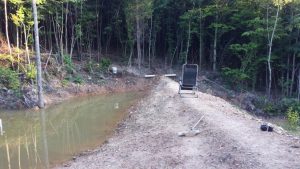
It overflowed during excessive Spring rain events. but drastically receded during the summer last year because of irrigation water use and being emptied to keep the goldfish pond filled. The dam holds water very well and I’m waiting to see if the summer gets dry enough to bring down the water level so I can move in the backhoe and complete the construction.
I’ve already started to build up the first part of the dam wall, but it’s tough to compact clay right at the water line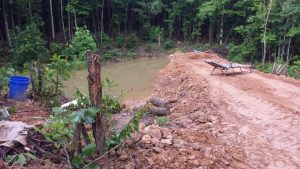
In another month, if the water is not down, I will drain it and then finish building the dam. (it’s great to swim in at this level) Once completed I plan to stock it with Koi.
Plan This is an overview of the half of the property(red boundary). Difference in elevation is about 100′ from lower right to upper left and the two ponds at the bottom of the picture are all in the same gully that runs downhill from right to left. The small pond pictured just above those two
This is an overview of the half of the property(red boundary). Difference in elevation is about 100′ from lower right to upper left and the two ponds at the bottom of the picture are all in the same gully that runs downhill from right to left. The small pond pictured just above those two
 has never really held water yet, but it does show signs of improving it’s water retention. This may change over time with organic matter and better integration of the swale, but that requires completion of the Low Gully Dam.
has never really held water yet, but it does show signs of improving it’s water retention. This may change over time with organic matter and better integration of the swale, but that requires completion of the Low Gully Dam.
At the very top of the plan drawing the pond touches a neighbors property and there needs to be some sort of written agreement to establish clear rights and responsibilities regarding it’s construction, use, and maintenance before beginning construction. At present the long connecting swale ends just before the pond location, and if no arrangement is reached that swale will be extended up along the property line to collect more water that would otherwise flow off the property.
This picture was taken at a very low water level, and believe it or not there are

catfish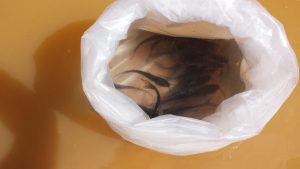 that survived the winter at this water level (only a couple feet deep). This year they are over a foot long!
that survived the winter at this water level (only a couple feet deep). This year they are over a foot long!
This “high gully dam” is in it’s second year. It overflowed once,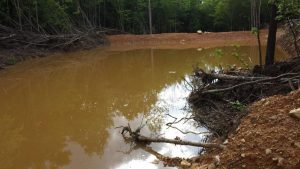
filled two or three times, but is still filling the “back country”. Dams are meant to hydrate the landscape, and the process generally takes about seven years. Currently this dam is the focus of most backhoe energy,  while it may not be obvious in the picture, the dam has been holding back the flood with a wall thickness of only 2 feet or less at the top
while it may not be obvious in the picture, the dam has been holding back the flood with a wall thickness of only 2 feet or less at the top
 but as this picture shows, the added mass will more than double the width of the dam wall, and the actual compaction will also be much better.
but as this picture shows, the added mass will more than double the width of the dam wall, and the actual compaction will also be much better.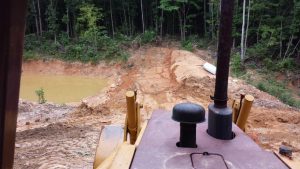
and a great deal of mass has been added to the dam wall, as well as clearing much more of the area to the left and top of the picture to prepare for further excavation.
 Goldfish pond (not shown on plan), a bit murky after a rain
Goldfish pond (not shown on plan), a bit murky after a rain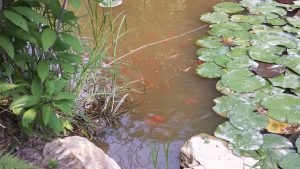 A close in snapshot of the gold fish pond. This was created when the driveway was put in about 15 years ago, and has boasted hundreds of fish, all descended from a few 38 cent babies from Walmart. There have also been crayfish, herons, and one huge snapping turtle that have all visited the pond at different points. Needless to say I try to discourage the heron(s) and snapping turtles with varying degrees of success.
A close in snapshot of the gold fish pond. This was created when the driveway was put in about 15 years ago, and has boasted hundreds of fish, all descended from a few 38 cent babies from Walmart. There have also been crayfish, herons, and one huge snapping turtle that have all visited the pond at different points. Needless to say I try to discourage the heron(s) and snapping turtles with varying degrees of success.
Last year the fish in this pond suffered with dry weather throught the fall and winter, and the fish population was cut in half. Some of my favorite older fish disappeared and many smaller ones as well. But this year they are making a comeback and water levels are doing pretty good, so with luck they will continue to increase populations again.